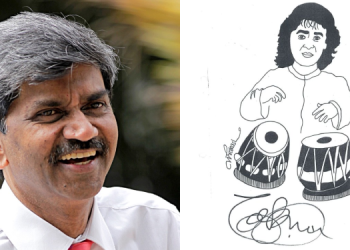A LinkedIn post by my friend Ashish Bhasin triggered this article. The post was about a new book co-authored by John Philip Jones and Mary Baumgartner Jones, Advertising at the Crossroads. I haven’t read the book.
In absolute dismay, I asked myself, when was it that advertising was never standing there in a confused state? Many brand owners wearing the “herd” blinkers have all been struggling at the crossroads since time immemorial.
Coca-Cola had, couple of weeks back, lit up the Burj Khalifa to let people experience the brand promise of Real Magic. The act was aimed at telling people there’s real magic all around, when people come together in unexpected moments that elevate the everyday into the extraordinary.
A small country restaurant in France, Le Petit Chef came up with an original idea to entertain guests while they were waiting for their order, by using an overhead projector on the ceiling. See the video below.
Both done at different scales, but managed to elicit a wow response from the audience. That’s the beauty of ads actually becoming acts. They both had a marriage of inspiring creativity and technology. A tall building and a dining table became the channels of communication and finally the world is getting to see it. This is what original thinking that touches the limbic brain does.
The fundamental challenge is the domination of buzzwords, forgetting that at the end we are dealing with humans. The urge to create “interactive” advertising hasn’t propelled the need for interacting with fellow humans. Similarly, the fact that we are talking to 4 different generations, hasn’t raised a question as to whether we need a check on the human sensibilities that will be responding to advertising.
To be more efficient (don’t know if it indeed was also effective) media and creative were compartmentalised first. Then came digital and media got further compartmentalized. Inspiriting creativity lost its way to transactional come and buy me ads. Then came click farms and ad frauds and clients started setting up programmatic desks within their organizations, yet pro-pragmatic approach kept missing their radars.
Big data became a conversation point, but most never even bothered to understand the journey their own customers went through or their frictions. Digital transformation for some was equal to process automation.
Some advertisers then decided they needed a single point of accountability and brought all the broken pieces together. And few dismantled it again at a faster pace than how it was brought together.
Then there were the influencers till they had to put the sponsored stamp on their feeds. And came the news of the cookie-less world and advertisers started realising the walled gardens were their safer bet till they figured out the trouble of collusion and unfair practices even there. Now other smaller walled gardens will open up, people who can boast of quality first party data. We will also soon see a sprint towards metaverse, everyone trying to own a piece and create something. Digital, Social, Big Data, Influencers will all give way to Metaverse in cocktail and boardroom conversations.
But what will change? Practically nothing, although advertising is no rocket science. It just needs 4 constituents coming together with exactly the same vision to deliver very inspiring advertising. It is that simple.
Here’s is link to 4 of my past articles, all published in Economic Times, Brand Equity
https://brandequity.economictimes.indiatimes.com/be-blogs/author/648/s-yesudas
- When advertising no longer cuts it – 6 years ago
- Marketing sans frontiers – 5 years ago
- The imminent death of agency commission – 4 years ago
- Big data: the loser’s game marketer’s play – 3 years ago
A quick glance at any of them can tell us why I believe the scenario has been the same for years and I expect no changes either unless there’s an intentional investment in change.
I’m not for a minute saying all these experiments by brands have been unworthy. But what I’m also reminded of is this data I came across sometime back on patent filing in India vs other Asian countries. With all the “digital” noise, as a country we are only sitting at the bottom in terms of originality. Has the herd mentality pushed us to the crossroads, where we are always waiting for someone else to show the way?
What can possibly change so that the road ahead is the safest bet for your brand?
- Firstly, understand advertising is more than just those TV/Print/Digital ads. It is an overall experience. Get rid of those blinkers and have an open view of the possibilities and make prudent decisions. Technology can at best accentuate human behavior and not replace them. The consumer will always have the upper hand. People got up and changed the channels even before the remote. Even if the prediction of Nicholas Negroponte were to come true that future of advertising will see an inversion: Instead of advertisers soliciting response, they’ll respond to solicitations by potential customers, the brands still need to create a baseline. This needs some long term thinking, even if the CMO isn’t sure about his tenure with the company.
- The formats in which advertising getting delivered many consist of many options like big impacts, visual conversations, games, simulations and the channels could even be buildings and dining tables, but let your creative expressions and when possible interspersed with technology, taking human sensibilities into account, help you build your baseline. Transactional ads don’t build your brand’s baseline. Inspiring creative which also has the potential to become acts, does and it provides RoI as well. Transactional advertising only demands SoV (Share of Voice). Once you filter all the “impressions” and get down to real RoI, you will know that in the Indian context, traditional media still scores better.
- Create a trusting relationship with your agency partners so that they don’t need to worry about making money behind our back. Pay them fairly but hold them accountable for their recommendations and actions.
- As the father of advertising David Ogilvy once said “Talent, I believe, is most likely to be found among nonconformists, rebels, and dissenters” Identify such talent in the agencies and among your team without being insecure. They may even be juniors. But hear them out. The CMO must have agenda less conversations with them. Intentionally invest in such talent.
- Invest in understanding your customers and solving their challenges. Move customer centricity from a department to the culture in the company, from the doorman to the CEO. You may have real influencers there who love your brand.
- Maya Angelou had said “I’ve learned that people will forget what you said, people will forget what you did, but people will never forget how you made them feel” Make your customers feel awesome. When Jeff Bezos said “I will lose money to keep my customers happy” many laughed. But based on personal experience I can say Amazon indeed is the best example of customer centricity. This will also mean empowering your people. It is more than just setting up a chat bot. How many times have the CEO/CMO become mystery callers at the call centre or reviewed the recorded customer conversations? There’s no better advertising than your customers being your real ambassadors.
- Encourage media owners to talk to you, particularly the regional ones, present their ideas and have conversations, because their knowledge about their markets and their ability to think on the feet on solutions can never be represented through an agency. Have your agency part of the conversations too. Just as an example, as I started figuring out the capabilities of Mathrubhumi in becoming the gateway to Kerala for deserving brands, it was truly a delight for me that partnership of the nature this group offers really exists in today’s world. It is a crime for brand owners to be oblivious of such opportunities as the agencies will only focus on beating the media down on rates.
- Identify people even at the media owners’ side who are genuinely trying to create solutions for you. Become their go-to client and make them your go-to media owner. You will be amazed at how you can win in those markets.
- The law of diffusion of innovation truly works. When you embark on anything new, which is not mass market yet, stay invested in the innovators and mass market will eventually happen. Else, you wouldn’t be seeing the Le Petit Chef video today.
- Have clear idea at what point will you be giving up on something. And do give up at that point even if it the project is a failure. But let that not dissuade you from investing in the next one. Failures are only good if it the data from that becomes fodder for future success.
Happy Advertising or may I say Actvertising.
Article is authored by S Yesudas , Co-founder Y&A Transformation and Group Strategic Advisor, Mathrubhumi Group.

















